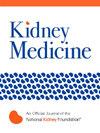IF 3.2
Q1 UROLOGY & NEPHROLOGY
引用次数: 0
摘要
背景腹膜透析(PD)可保留肾脏功能并提供灵活性;然而,与血液透析(HD)相比,接受腹膜透析的年轻人很少。本研究旨在了解从腹膜透析转为血液透析的影响因素。研究设计这是一项顺序解释性混合方法研究。设置与ampamp; 参与者从1987年至2015年间接受透析的470名参与者(50%为男性参与者,85%为白人,平均年龄:16岁)中收集了定量数据。采用 Cox 比例危险分析法研究了从 PD 过渡到 HD 的相关社会心理因素。从 2013 年至 2015 年间接受透析的 13 名年轻成人(14-29 岁)中收集了定性数据,并于 2020 年进行了回顾性访谈。透析1年和5年的存活率分别为71%和37%。过渡到 HD 的风险因素包括年轻成年(年龄:15-30 岁),年龄越大过渡风险越高(年龄:15-19 岁,HR:2.41;年龄:20-24 岁,HR:3.39;年龄:25-30 岁,HR:3.14;P <;0.005)。其他因素包括原发性肾病类型(全身性疾病与肾小管间质疾病)。转院的主要原因是感染(50%)、不遵医嘱(21%)和机械问题(18%)。定性分析揭示了有关沟通治疗方案、生活影响和支持结构的关键主题。该研究基于横断面社会心理数据,缺乏详细的父母参与情况,可能存在回忆偏差。结论由于移植失败和腹膜透析并发症,年轻人向 HD 过渡的风险较高。人们低估了腹膜透析所带来的挑战,因此有必要向青壮年宣传所有透析方案。建议提供更多支持,包括心理健康支持、同伴支持和生活变化期间的支持,如搬出家庭住所。这项研究旨在了解为什么年轻人更有可能从腹膜透析(PD)转为血液透析。虽然腹膜透析可保留肾功能并具有灵活性,但很少有年轻人选择腹膜透析。我们采用混合方法对 470 名 0-30 岁的患者进行了研究,并对 13 名正在接受透析的人进行了访谈。我们的研究结果表明,年轻人(15-30 岁)转为血液透析的风险较高,主要原因是感染、不依从性和机械问题。人们低估了血液透析所面临的挑战,因此有必要向青壮年宣传所有透析方案。建议提供更多支持,包括心理健康支持、同伴支持和生活变化期间的支持,如搬出家庭住所。本文章由计算机程序翻译,如有差异,请以英文原文为准。
Peritoneal Dialysis in Young Adults: A Mixed-Methods Study
Background
Peritoneal dialysis (PD) preserves kidney function and offers flexibility; however, few young adults have it compared with hemodialysis (HD). This study aimed to understand factors influencing the change from PD to HD.
Study Design
This was a sequential explanatory mixed-methods study.
Setting & Participants
Quantitative data were collected from 470 participants (50% male participants, 85% White, mean age: 16 years) who received dialysis between 1987 and 2015. Cox proportional hazards analysis was used to examine psychosocial factors associated with transitions from PD to HD. Qualitative data were gathered from 13 young adults (aged 14-29 years) who received dialysis between 2013 and 2015, with retrospective interviews conducted in 2020.
Results
25% of participants experienced multiple episodes of PD. Survival rates for PD at 1 and 5 years were 71% and 37%, respectively. Risk factors for transitioning to HD included young adulthood (age: 15-30 years), with higher transition risks in older age groups (age: 15-19 years, HR: 2.41; age: 20-24 years, HR: 3.39; age: 25-30 years, HR: 3.14; P < 0.005). Other factors included primary kidney disease type (systemic diseases vs tubulointerstitial diseases). Leading causes for transition were infection (50%), noncompliance (21%), and mechanical issues (18%). Qualitative analysis revealed the key themes around communicating treatment options, life impact, and support structures. Resilience was an additional theme among those who continued PD.
Limitations
The study was based on cross-sectional psychosocial data, lacked detailed parental involvement, and may have suffered recall bias.
Conclusions
Young adults are at higher risk of transitioning to HD owing to both transplant failure and complications with PD. Challenges of PD have been underestimated, and there is a need to educate young adults well on all dialysis options. Additional support including mental health support, peer support, and support during life changes, such as moving out of their family home, is recommended.
Plain-Language Summary
This study aimed to understand why young adults are more likely to switch from peritoneal dialysis (PD) to hemodialysis. Although PD preserves kidney function and offers flexibility, few young adults choose it. We conducted a mixed-methods study with 470 patients aged 0-30 years and interviews with 13 individuals who were receiving dialysis. Our findings showed that young adults (aged 15-30 years) were at higher risk of transitioning to hemodialysis, mainly owing to infections, noncompliance, and mechanical issues. Challenges of PD have been underestimated, and there is a need to educate young adults well on all dialysis options. Additional support including mental health support, peer support, and support during life changes, such as moving out of their family home, is recommended.
求助全文
通过发布文献求助,成功后即可免费获取论文全文。
去求助

 求助内容:
求助内容: 应助结果提醒方式:
应助结果提醒方式:


